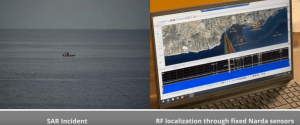Monitoring marine radio emergency frequency for more effective coordination of rescue operations
Narda Safety Test Solutions has been intensively involved in the Nestor project. In this EU-funded project, companies, border control government agencies and
research institutes worked on a multi-sensor platform that would (among others) serve to improve the detection and localization of shipwrecked persons:
1. Using Narda STS’s SignalShark and ADFA, specific marine and emergency radio frequencies were monitored and bearings were taken to define the direction of a potential rescue operation. It’s aimed to facilitaten the search and rescue operations in a maritime environment. The trial was conducted in Larnaca, Cyprus, hosted and coordinated by the Joint Rescue Coordination Center (JRCC).
2. As a result of these findings, cameras could be pointed in the likely direction of the emergency situation and the search area was clearly narrowed down. The test clearly showed that the additional use of radio frequency direction finding helped to locate shipwrecked persons significantly faster and more efficient compared to searching with traditional means such as cameras or from helicopters. The test clearly showed that the additional use of radio frequency direction finding helped to locate shipwrecked persons significantly faster compared to searching only with a camera. Shipwrecked persons could also be located when camera-based systems reach their limits, for example in stormy / foggy / night conditions.

The SignalShark and the ADFA were installed close to the coast and successfully tested up to a distance of about 10km. After successfully determining the signal direction supported by geolocation software, the information was transferred to a BC3i platform. The rescue team utilized a camera and a drone to gather further information.
The SignalShark with automatic direction-finding antenna ADFA proved to be extremely advantageous due to:
• The high bearing sensitivity
• The high bearing accuracy
• The best-in-class IMFDR (intermodulation free dynamic range)
• The collaborative bearing feature allowing multiple bearings to be combined along the coastline for geolocalisation
• The simple, common mounting on a special tripod from Narda STS,
• The SignalShark outdoor receiver can also be mounted very close to the automatic direction-finding antenna when mounted on high masts. This results in a low-loss RF connection supporting the high bearing accuracy.
• This allows long distances for power supply and control over the same cable thanks to Power-over-Ethernet.
For more information, please contact CN Rood.
